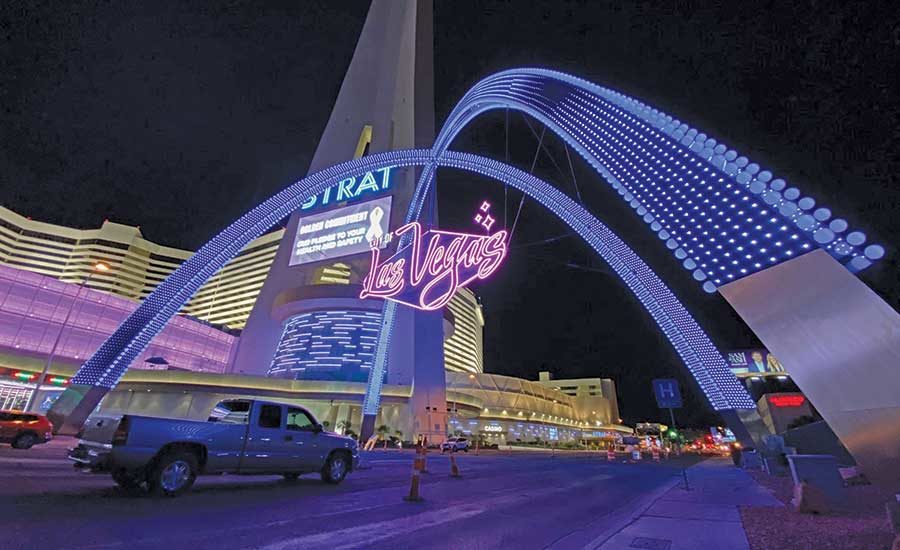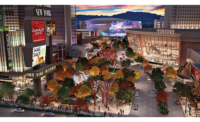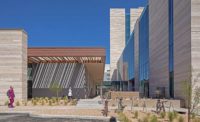Streets and sewer lines are not the first things that come to mind at the mention of Las Vegas. Yet behind the famed glitz and glitter, Vegas is a large, steadily growing city—the 28th most populous in the U.S., as of 2019. And with size comes a full slate of urban infrastructure and building needs.
“Aging infrastructure is what public works directors worry about,” says Mike Janssen, the city’s executive director of community development. He recalls his early days with the city’s public works department, wondering why his predecessors were so focused on sewer and storm-drain assessments, even though the systems at the time were “only” about 25 years old.
“‘They’ll get older,’ they assured me,” he says, “and of course, they were right.”
That forward-thinking approach has served the city well over the years, as have two successful local tax measures that provide a reliable source of funding for infrastructure programs. But Janssen says the city’s strategies have adapted to changing tastes. Where traffic signals were once a go-to solution for keeping vehicles moving, the city now takes a more holistic approach to managing its busy street network.
For example, many of the oldest sections of downtown Las Vegas are being redeveloped into a more pedestrian-friendly environment for occupants of the area’s new high-rise residences.
“Before, we would just do a basic street upgrade with a sidewalk and streetlights,” Janssen says. “Now, we’re incorporating shade trees, bike and bus rapid-transit lanes and other amenities that give downtown a different feel.”
Main Street
Few projects encapsulate the opportunities and challenges of this effort more than the three-year, $125-million reconstruction of Las Vegas Boulevard, which began in April 2020. As the city’s largest-ever public works project, the makeover of the primary corridor in the south downtown area combines a complete rehab of streets with replacement of water, sewer and drainage systems, plus some elements that predate the area’s earliest resorts.
Engineering project manager Gina Venglass says a funding partnership with the Las Vegas Valley Water District allowed the city to take a more comprehensive approach to the corridor, thus averting disruptive piecemeal projects that would have repeatedly inconvenienced visitors and residents alike.
“This way, we can do it all at once, and do it right,” Venglass says.
The rebuild is being carried out by Las Vegas Paving under a construction manager at-risk (CMAR) contract. As is often the case with a major reconstruction, the project team has encountered its share of undocumented utilities, from a perfectly preserved 1920s-era redwood water pipe to data lines installed by technology companies that were long ago swallowed up by IT mergers.
Still, Las Vegas Paving project manager Bren Wick says such documentation gaps are about the only surprises that accompany city-sponsored work.
“They do a good job with putting out designs and processes that have identified and vetted key areas and issues,” says Wick, whose company has performed multiple CMAR infrastructure upgrades in the downtown area. “There’s also a big focus on working with community and stakeholders, which we can appreciate, being residents of the city ourselves.”
Oasis of Innovation
The Las Vegas Boulevard upgrade is also benefiting from Las Vegas-style creativity, such as a decision to salvage hundreds of mature palm trees uprooted from the median to facilitate excavation work.
“The trees have been transplanted to a palm farm, where they’re being cared for until the median is restored,” Venglass says. “We’ll replant them, along with new trees and incorporate some refurbished historic neon signs as well.”
Another signature element of the reconstruction puts a twist on design-build delivery—the two 80-ft-tall illuminated steel arches featuring a suspended sign, recently erected near The Strat Hotel. That’s because Salt Lake City-based sign manufacturer YESCO also served as the project lead.
“While this was a public works project, we didn’t have in-house sign construction expertise,” explains city engineering project manager Cassandra Watson Mihelcic. “YESCO wasn’t used to being a general contractor, but good communication between both sides helped get it done.”
Although CMAR is the city’s most frequently used delivery option for infrastructure projects, all options are on the table, depending upon the needs and opportunities at hand. The city used design-bid-build for the $33.1-million Symphony Park Parking Garages, which added a pair multilevel municipal structures to serve a nearby performing arts facility, and forged a public-private partnership with the Molasky Group of Cos. to build a $56.3-million, 140,000-sq-ft municipal courthouse on a one-acre site near City Hall.
“The Clark County justice center was growing so much that they needed new courtrooms, so we did the P3 for the new municipal courthouse across the street,” says city architectural project manager Shelly Hayden. Scheduled to open this spring, the new courthouse will help anchor what will eventually be a complex of city-owned administrative facilities.
As with other city projects, knowledge is power for courthouse contractor Martin-Harris Construction. “The city makes our lives easier because they know their expectations, and they’re very participative,” says Guy Martin, president of Martin-Harris. “They’re at the table, and that helps us understand what’s needed.”
Ready for a Rebound
Although COVID-19 took a bite out of Las Vegas’ $58-billion tourism industry last year, Vegas is still Vegas, which is why city officials have expressed optimism that visitors and convention attendance will quickly return to prepandemic levels. Even with casinos and other attractions all but empty for much of 2020, efficiently moving millions of people remained a top priority.
“We’re open to any transportation mode we can get,” says Janssen, who’s particularly excited about the Vegas Loop, an on-demand underground public transit system being developed by Elon Musk’s Boring Co. The system will use Tesla-like autonomous vehicles to transport passengers between McCarran International Airport, the Las Vegas Strip and downtown.
Plans call for the Boring Co. to build the system’s base tunnel, with resort hotels and other landowners financing design and construction of the stations. The Las Vegas City Council has already granted the project a special-use permit within the city limits, with Clark County expected to follow suit for its portion of the system this spring.
While there’s no announced construction timeline for the Loop, Janssen says the city has provided the Boring Co.’s design team with its 3D CAD files for Las Vegas Boulevard and other parts of the Loop’s route where infrastructure upgrades are complete or in progress.
“They’ve told us that’s given them several months head start,” he adds.
Meanwhile, the city has many other projects on its near-term agenda. Reconstruction of Las Vegas Boulevard north of downtown is in the design phase, as is a $45-million circular pedestrian bridge at West Sahara Avenue and Las Vegas Boulevard that will improve the intersection’s traffic capacity.
The city also is bidding a $57-million storm drain system to alleviate flooding in neighborhoods west of downtown.
Another ongoing city-sponsored project is the Corridor of Hope Courtyard, which provides a sheltering station and other services for the city’s large homeless population.
Martin says the city-funded building opportunities are welcome at a time when the local construction market has slowed somewhat by what he deems a temporary lull between major commercial and hospitality projects. He credits the mayor and the city council for continually doing what’s needed for the community and maintaining the city’s standing as a world-class destination.
“Las Vegas,” he says, “is the greatest city in the world.”









Post a comment to this article
Report Abusive Comment